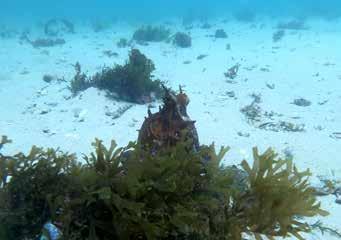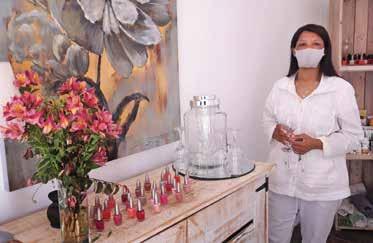8
www.thevillagenews.co.za
FROM THE EDITOR
9 December 2020
The new facts of life
Talking about the facts of life may not be the easiest of discussions, but it is a vital one. In the same way reporting over the last 10 months on the Covid-19 pandemic has not been easy. While we have all gotten used to the basic implications of the global pandemic, it still remains a sensitive issue. The main reasons for this are the right to privacy of those who have become infected, a relentless stream of mis- and mal-information, and an ever-changing understanding of what the virus is, how it infects peo-
ple, what the symptoms are and what we can do to prevent infection. While it is easy to access information on the virus by simply clicking on a website, the most important thing for any publication is to ensure that the information it publishes is credible and from reliable sources. In our endeavours to live up to this, we put in hours of research, checking, and double-checking each fact and source. And although we make every effort to ensure accurate information, we all can be misled. Very few among us did not
NEWS WhatsApp or SMS your stories and photos to 083 700 3319 De Waal Steyn
E: dewaal@thevillagenews.co.za
Hedda Mittner
CONTENT EDITOR T: 083 645 3928
E: hedda@thevillagenews.co.za
Raphael da Silva ONLINE EDITOR T: 074 125 5854
E: raphael@thevillagenews.co.za
Elaine Davie
JOURNALIST T: 084 343 7500
E: elaine@thevillagenews.co.za Taylum Meyer PRODUCTION MANAGER, PHOTOGRAPHY & DESIGN T: 084 564 0779
E: taylum@thevillagenews.co.za
and what we must do if we become infected. To a large extent it became the focus of our very existence and we could barely speak of anything else.
But as the pandemic unfolded, we became increasingly aware of its dangers and the lasting side effects this devasting virus has – physically, emotionally, socially, and economically.
With time, however, the virus became a less important factor in our lives as we started returning to a semblance of our normal way of life. We appreciated every liberty that was returned to us as the lockdown restrictions relaxed.
As our understanding of the virus increased so did our reaction to it. We slowly became aware of how highly contagious it is, how it is spread
And while we are still grappling with the new normal and the festive spirit grows, we need to remember the hard
lessons we have been taught during the year. Social distancing, wearing masks, disinfecting surfaces and hands and avoiding large gatherings are among them. Simple, easy, and reliable things we must do to stop the spread of the virus – a new set of the facts of life. Out of respect for each other, let’s stick to these rules and ensure that the rising curve is flattened as soon as possible. This is the good NEWS – Ed.
Coloured roots and laughter lines
THE VILLAGE
PUBLISHING EDITOR T: 083 700 3319
initially, when we first became aware of the virus, think that it might just be a bad case of flu and that governments were overreacting.
By Murray Stewart murray.stewart49@gmail.com
that ‘from henceforth, the colour of the lawn shall be referred to as green’? And when was it decided that whispering turquoise sounded provocative enough to assign it its own shade? Yellow sounds more like a greeting than a colour, and Pink, whether tickled or not requires an explanation, so we rummaged through the archives at the Explanation of Everything for answers.
T
he For Fact’s Sake columns are – according to Google and the Duck ’n Fiddle’s Explanation of Everything – based in truth. Occasionally however, names and places have been changed to protect innocent people involved.
In modern English, most of the colour names are the result of dialectic influences or drunken/sloppy mispronunciations over the centuries. Yellow, for example, was used in Old English from 1590 but was spelt geolu. This was derived from the Old High German gelo, similar to the Middle Dutch, ghele.
Hue and kraai Those of us fortunate enough to have the gift of sight, take colours for granted. I can describe a painting I’d bought to Susan in Perth, and by using references like forest green, post-box red or navy blue, she’ll be able to envisage it in her mind’s eye.
The word orange dribbled into the English language pool around 1512, and is derived from the Persian narang which in turn comes from the ancient Sanskrit naranga. It described the colour of the fruit as far back as 400BCE, but oranges were unheard of in Europe until the 12th century, when Crusaders schlepped back pockets of them from the Holy Land.
But what if she was blind? How do you describe colours to someone born sightless? She’s been told that the sky is blue, but it is only an audio reference. Sadly, without the optical software to process colours, her mind’s eye would only ‘see’ in black and white, with fifty shades of grey in between – one for each colour she hears mentioned. But for the sighted, colours and their various shades have different names which we learn from an early age. The colour overhead is blue, sky-blue, but there again, so is a police light. Post boxes are red, but so is blood. Snow is white, but so is Trump. And an orange is orange, but there again, dare I say, so too is Trump.
Now purple is quite interesting. In early Greek the word was porphyra, a term for the shellfish-derived dye used by garment makers. In Latin it was called purpura and entered Old English around the 10th century. Who could have thought that the gooey mucus excreted by the spiny dye-murex sea-snail would become the preserve of royalty, nobility and the clergy, nogal.
Well, this got us wondering. Who decreed
Green comes from the Proto-Indian-European
word greh, which literally meant ‘to grow’. It filtered through Northern Europe as grani in Old Saxon, grouni in Old High German and groene in Middle Dutch, among others. The Italians though – under pressure from the Pope and the Mafia – refused to cooperate and stuck with Latin variations of verdi. As we all know, there are many more colours than just those in the rainbow. Sadly it would take the entire newspaper to discuss them all, so just Google Etymology/colours and astound everyone at the Crochet Club next week with your profound knowledge of the colour spectrum. Here’s how... “Hi Sandra, that’s a beautiful lilac blouse. (Thanks.) Do you know where the word lilac comes from?” (No.) Then the floor is yours. It’s still rather baffling though, why some colours have alternative names which are bandied about by the hoity-toity arty-farty brigade. Life’s difficult enough as it is to worry about what cyan is, or cerise, or carnelian for that matter. No laughing matter Sir Mick Jagger, whose face looks like it’s been slept in, was interviewed on TV, and was asked if he’d ever considered having a face-lift to eradicate his rather well-defined wrinkles and creases. “They’re not wrinkles,” retorted Mick smugly, “they’re laughter lines!” The perplexed interviewer paused... then shook her head. “Nothing can be that funny.”
Charé van der Walt MARKETING & SALES MANAGER T: 082 430 1974
E: chare@thevillagenews.co.za
HERMANUS: SEVEN-DAY WEATHER AND TIDE TABLE Wed | 9 Dec
Thu | 10 Dec
Fri | 11 Dec
Sat | 12 Dec
Sun | 13 Dec
Mon | 14 Dec
Tue | 15 Dec
14°/16° Some Rain
15°/17° Partly Cloudy
14°/24° Clear
16°/23° Clear
16°/24° Clear
18°/21° Partly Cloudy
17°/19° Some Rain
Nickey Jackson
SALES REPRESENTATIVE & DESIGN T: 079 408 7722
E: nickey@thevillagenews.co.za
ADMIN & FINANCE
E: admin@thevillagenews.co.za
MEMBER OF THE Audit Bureau of Circulations of SA 11 208 audited weekly circulation
LOW HIGH LOW HIGH
04:01 10:32 17:06 23:15
LOW 05:14 HIGH 11:37 LOW 18:09
HIGH LOW HIGH LOW
00:20 06:17 12:34 19:02
HIGH LOW HIGH LOW
Proudly Sponsored By
Talisman Tool Hire WEATHER: www.yr.no / TIDES: www.tide-forecast.com
01:14 07:11 13:25 19:50
HIGH LOW HIGH LOW
02:02 08:01 14:12 20:35
HIGH LOW HIGH LOW
02:47 08:48 14:58 21:18
HIGH LOW HIGH LOW
03:31 09:34 15:43 22:00
De Bos Dam N/A Last week 99.96%
Weekly Rainfall N/A Last week 9mm
















